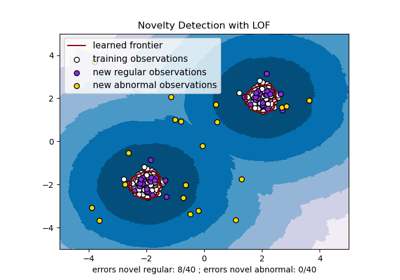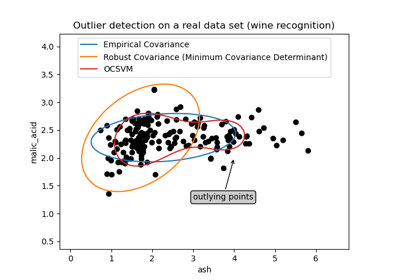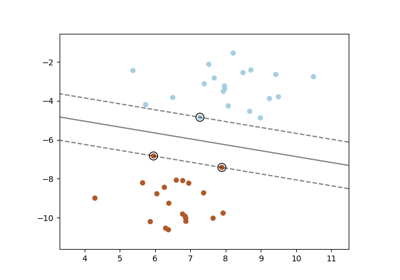Note
Go to the end to download the full example code or to run this example in your browser via JupyterLite or Binder.
One-class SVM with non-linear kernel (RBF)#
An example using a one-class SVM for novelty detection.
One-class SVM is an unsupervised algorithm that learns a decision function for novelty detection: classifying new data as similar or different to the training set.
# Authors: The scikit-learn developers
# SPDX-License-Identifier: BSD-3-Clause
import numpy as np
from sklearn import svm
# Generate train data
X = 0.3 * np.random.randn(100, 2)
X_train = np.r_[X + 2, X - 2]
# Generate some regular novel observations
X = 0.3 * np.random.randn(20, 2)
X_test = np.r_[X + 2, X - 2]
# Generate some abnormal novel observations
X_outliers = np.random.uniform(low=-4, high=4, size=(20, 2))
# fit the model
clf = svm.OneClassSVM(nu=0.1, kernel="rbf", gamma=0.1)
clf.fit(X_train)
y_pred_train = clf.predict(X_train)
y_pred_test = clf.predict(X_test)
y_pred_outliers = clf.predict(X_outliers)
n_error_train = y_pred_train[y_pred_train == -1].size
n_error_test = y_pred_test[y_pred_test == -1].size
n_error_outliers = y_pred_outliers[y_pred_outliers == 1].size
import matplotlib.font_manager
import matplotlib.lines as mlines
import matplotlib.pyplot as plt
from sklearn.inspection import DecisionBoundaryDisplay
_, ax = plt.subplots()
# generate grid for the boundary display
xx, yy = np.meshgrid(np.linspace(-5, 5, 10), np.linspace(-5, 5, 10))
X = np.concatenate([xx.reshape(-1, 1), yy.reshape(-1, 1)], axis=1)
DecisionBoundaryDisplay.from_estimator(
clf,
X,
response_method="decision_function",
plot_method="contourf",
ax=ax,
cmap="PuBu",
)
DecisionBoundaryDisplay.from_estimator(
clf,
X,
response_method="decision_function",
plot_method="contourf",
ax=ax,
levels=[0, 10000],
colors="palevioletred",
)
DecisionBoundaryDisplay.from_estimator(
clf,
X,
response_method="decision_function",
plot_method="contour",
ax=ax,
levels=[0],
colors="darkred",
linewidths=2,
)
s = 40
b1 = ax.scatter(X_train[:, 0], X_train[:, 1], c="white", s=s, edgecolors="k")
b2 = ax.scatter(X_test[:, 0], X_test[:, 1], c="blueviolet", s=s, edgecolors="k")
c = ax.scatter(X_outliers[:, 0], X_outliers[:, 1], c="gold", s=s, edgecolors="k")
plt.legend(
[mlines.Line2D([], [], color="darkred"), b1, b2, c],
[
"learned frontier",
"training observations",
"new regular observations",
"new abnormal observations",
],
loc="upper left",
prop=matplotlib.font_manager.FontProperties(size=11),
)
ax.set(
xlabel=(
f"error train: {n_error_train}/200 ; errors novel regular: {n_error_test}/40 ;"
f" errors novel abnormal: {n_error_outliers}/40"
),
title="Novelty Detection",
xlim=(-5, 5),
ylim=(-5, 5),
)
plt.show()
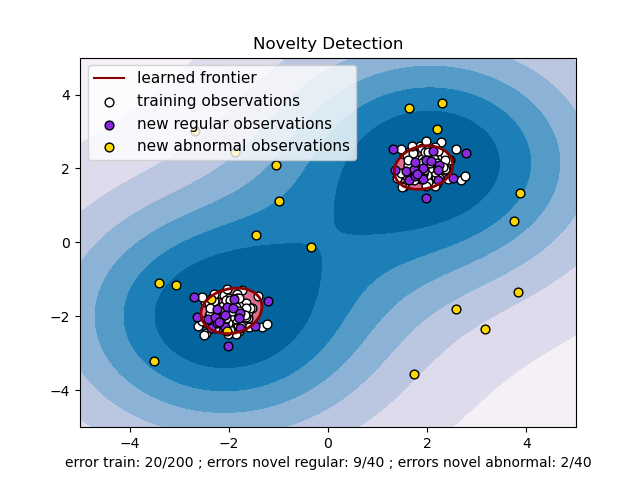
Total running time of the script: (0 minutes 0.132 seconds)
Related examples
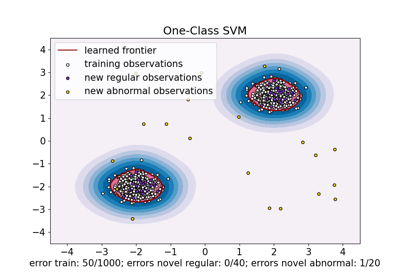
One-Class SVM versus One-Class SVM using Stochastic Gradient Descent
One-Class SVM versus One-Class SVM using Stochastic Gradient Descent
